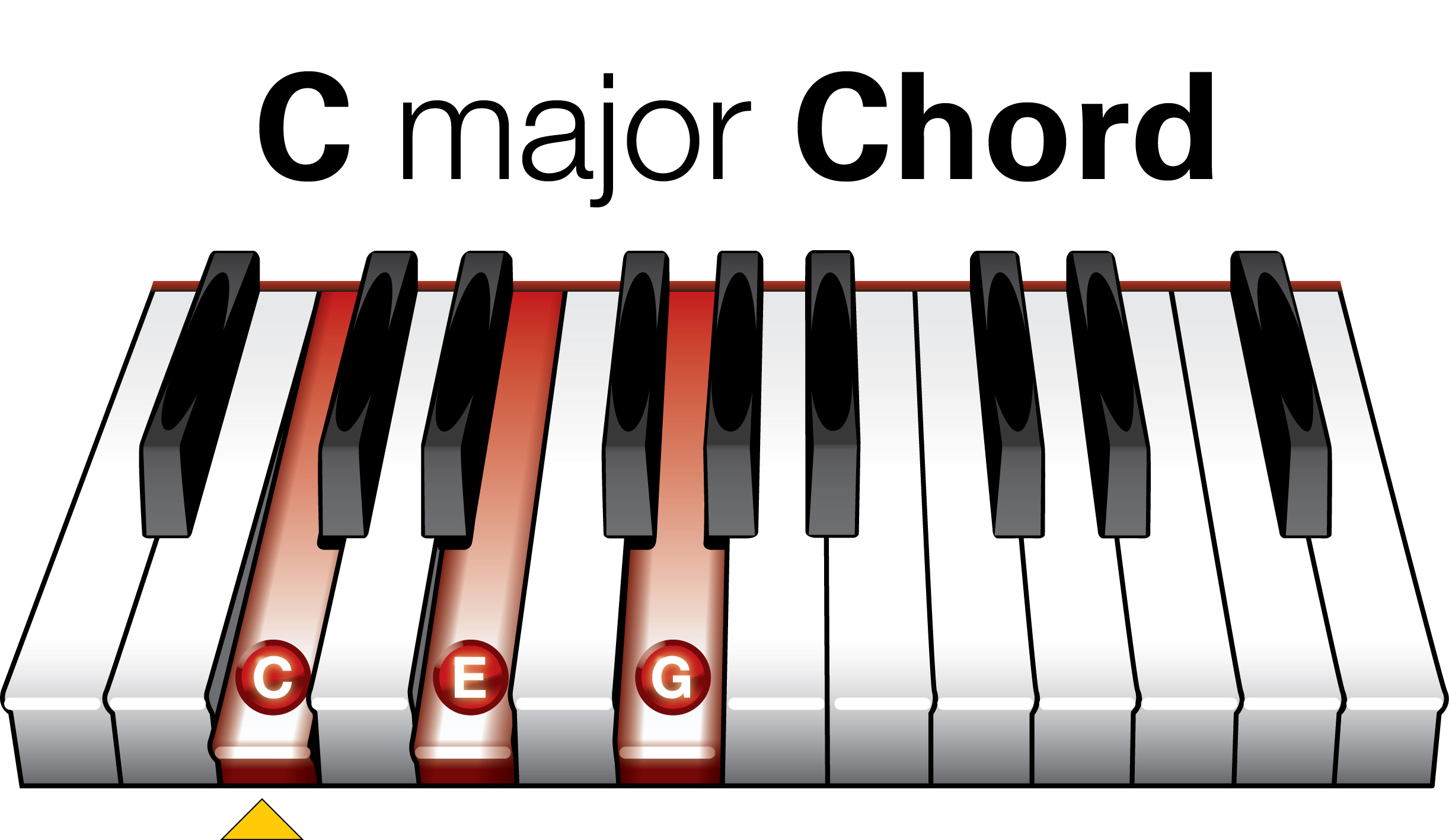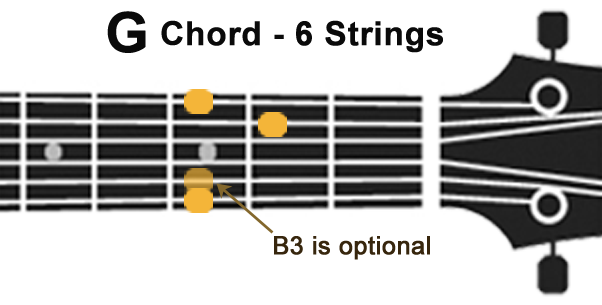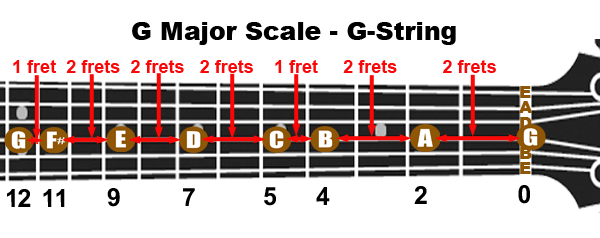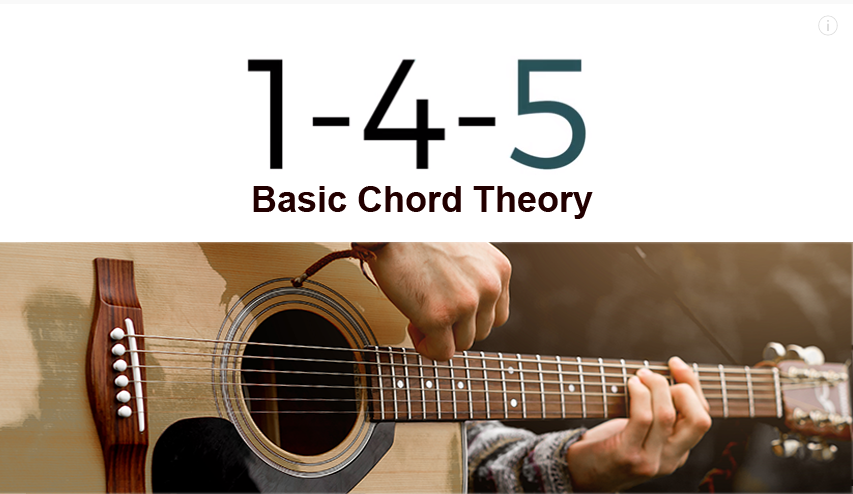Practice Tracks for ZoomGuitar
Basic Chord Theory
Basic Chord Theory covers the following topics:
- What is a "chord"?
- How are Chords, Scales and Keys related?
- What is a "chord progression"?
- What are the most common chord progressions?
Once you have even a very basic understanding of these topics you will be surprised how this information will make your guitar playing simpler and more intuitive.
So let's begin...
What is a Chord?
A chord is a combination of three or more notes. Chords are used to accompany melodies and to create interesting harmonies that enhance the mood and impact a song is meant to create.

Chords can be played all at the same time, as for example, on a piano or guitar. Or the notes can be played individually with a slow strum, or played one after the other with a pick or with your fingers. This is usually called an arpeggio.
Triads
In its most basic form a chord is a triad containing three notes. For example, a C major chord consists of the notes C-E-G. These notes are the first, third and fifth notes (1-3-5) of the scale they are built on. On a guitar or piano, chords often consist of more than three notes. These additional notes are either instances of the basic notes, often an octave higher or lower. For example, the G chord at the open position is usually the first chord guitar players learn. Across all six strings the notes are G-B-D-G-B-G.

Why these notes?
Because in the western tradition (as opposed to eastern or African or some other basic musical tradition) songs are based on specific kinds of scales. The chords that work for a song (sound right) are built from the notes of the scale the song is based on.
Chords and Scales
For example, when a song is written in the key of G Major, all we really mean by that is that it is built on the G Major scale. The notes in the song will be taken from the G Major Scale.

Notes of the G Major Scale played on the G string.
For example, let's say you are playing or singing the song "Ode to Joy" in the key of G Major. The notes of that version of the song will all belong the G Major scale, and will have a special relationship to the note G. This note is the starting point or "root" of that scale. It is the note the song will be built around and will finish on.
Because a chord consists of three notes, these notes, in a sense, interact with each other. A chord such as C Major - C-E-G - consists of notes that create a pleasing harmony with each other, and with the notes of the song they are being used to accompany. This is why some chords sound good in specific cases, and others don't.
For example, if you are strumming along with a song in the key of C Major and you play an E Major chord, it probably won't sound good. The E Major chord contains a note not found in the C Major scale - G# - and does not harmonize with the melody* (*unless the melody specifically includes the note G#). In this case the chord will have a jarring effect. It will be discordant or dissonant.
Composers of songs often add notes to chords that don't follow the basic 1-3-5 pattern. They do this to create different harmonic effects. For example, a basic 7th chord adds a flattened 7th note (minor seventh) from the scale. A G Major chord is turned into a G7 by playing E1 (F) instead of E3 (G). A Dsus4 chord moves the E2 (F#) of the basic D chord up to E3 (G). In this case, G is the 4th note in the D Major scale (that's where the "4" comes from).
How are Chords, Scales and Keys Related
The previous discussion should make the basic relationship between scales and chords clear. The "key" of a song is simply the root note of the scale the song is built on. So, for example, we say a song is in the key of D Major when the song is built on the D Major scale.
Basic Features of Scales
Scales come in a variety of types. Guitar players will become familiar with major, minor, pentatonic, and chromatic scales. Each of these scales has a few important features.
- First, a scale is a sequence of notes which are tonally separated in a specific way.
- Second, each scale has a specific starting point or "root", and ascends or descends to another note an octave away.
- Third, the "intervals" between the notes of the scale follow a specific pattern.
We generally define the intervals between various notes in terms of semitones and tones. A semitone is the smallest pitch interval between two adjacent notes. If you think of the piano keyboard, for example, each key is a semitone away from the adjacent key.
On a guitar string each fret produces a note a semitone higher than the fret below it (closer to the nut). We move up the neck of the guitar as we move away from the nut. The string gets shorter and the notes get higher in pitch.
In commonly-used guitar terminology each fret is a half step higher in pitch than the one below it (closer to the nut). Two frets is a whole step.
This is how we differentiate between different scales. For example, where "H" is a half step and "W" is a whole step, the intervals between successive notes in the various scales are as follows:
Major Scale: W-W-H-W-W-W-H
Minor Scale: W-H-W-W-H-W-W
Chromatic Scale: H-H-H-H-H-H-H-H-H-H-H-H
What Does This Have to do with Chords?

Specific chords are associated with the different notes of each major scale. And these chords also follow a specific pattern from key to key. This pattern tells us which chords sound good when playing along with songs in each key. The pattern is as follows:
Note 1 - Major ChordNote 2 - Minor Chord
Note 3 - Minor Chord
Note 4 - Major Chord
Note 5 - Major Chord
Note 6 - Minor Chord
Note 7 - Diminished Chord
This means the pattern of chords from key to key is Major, minor, minor, Major, Major, minor, diminished. So, for the key of C for example, the chords that "fit", depending on which notes are used in the song are: C Major, D minor, E minor, F Major, G Major, A minor, B diminished.
Notice that the Major chords in this list are 1-4-5 (or I, IV, V). This is why we use the 1-4-5 chords in so many songs. These are the chords that "fit" the majority of notes in most songs.
This happens because all of us in the western-European-American tradition are writing and playing from the same background, or, as they say, "singing from the same song book". This means there is a very strong tendency to create songs that sound familiar and use a well-known structure. These songs use the same scales and focus on the same types of note intervals that we are familiar with.
As a result the same pattern of chords is found in most popular songs. That pattern is what we call the 1-4-5 pattern where the chords used are predominantly the three major chords (1-4-5) with a sprinkling of minor chords thrown in here and there. The 7 chord (diminished) is rarely used.
The Bottom Line
The most important takeaway from all of this is that for strummng along with songs you should focus on the following:
- Learn what the most common keys are that you will be playing along with.
- Learn the I-IV-V chords for these keys, as well as the minor chords 2, 3, and 6 (ii, iii, vi)
- Learn typical "progressions" of chords.
Chord Progressions
Chords are typically found in sequences that tend to be repeated within different parts of the song. Here is an example: the I Chord is followed by the IV Chord, which is followed by the V Chord, which is then followed by the I Chord again. This would be represented as a I-IV-V-I progression.
Or take the song "Sign of the Times". The chord progression used in this song is I-vi-V-V. In the key of C the chords are C-Am-G-G. In the key of D they would be D-Bm-A-A, and so on.
Popular songs are often created by first developing a specific chord progression. Then the song creator builds a tempo, melody, and lyrics around that chord progression.
MuzicTrain.com
